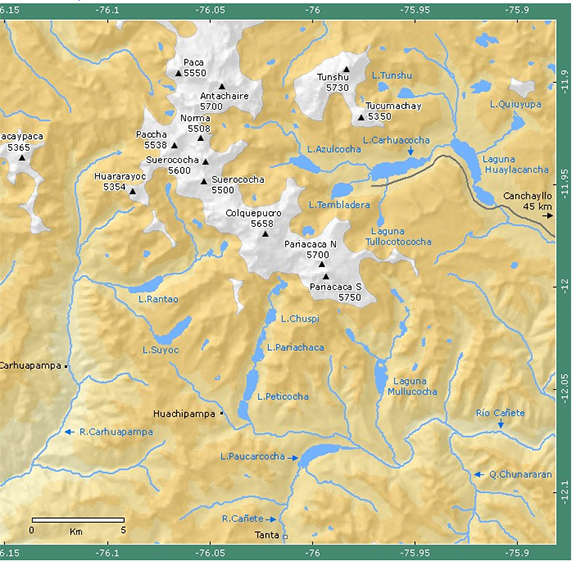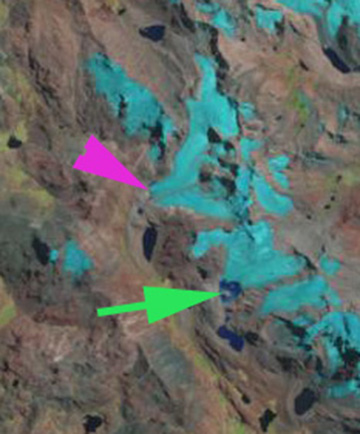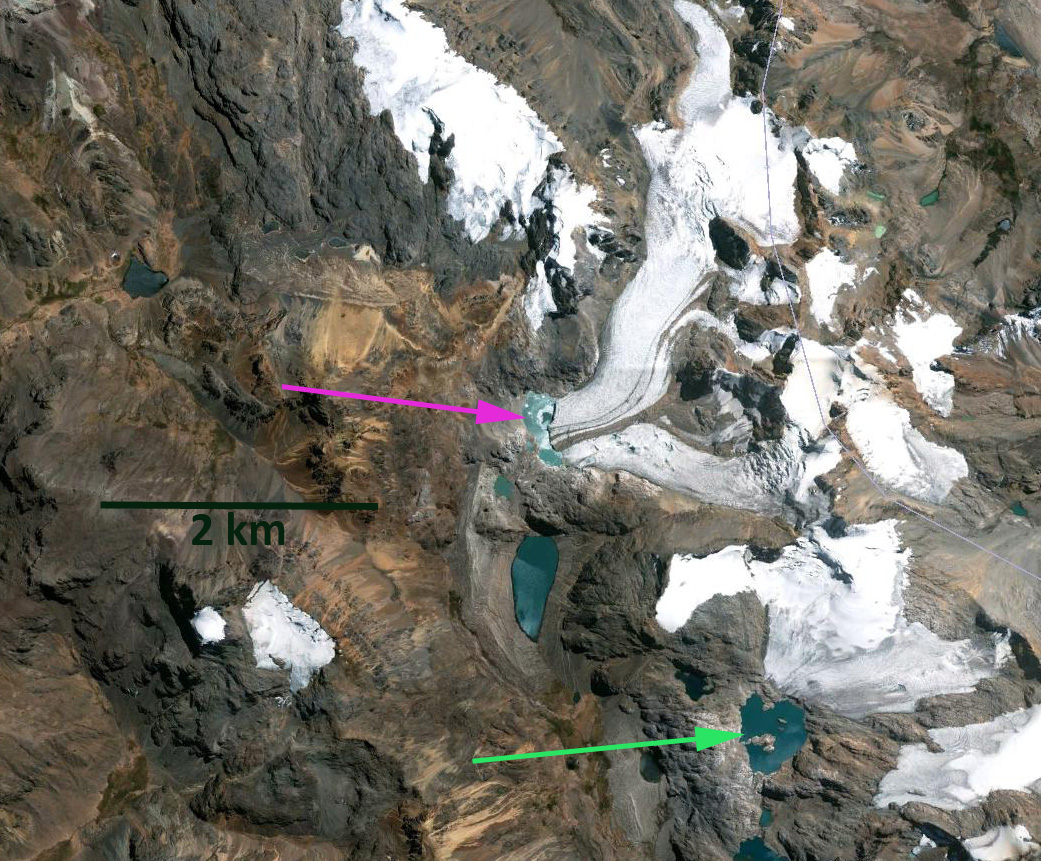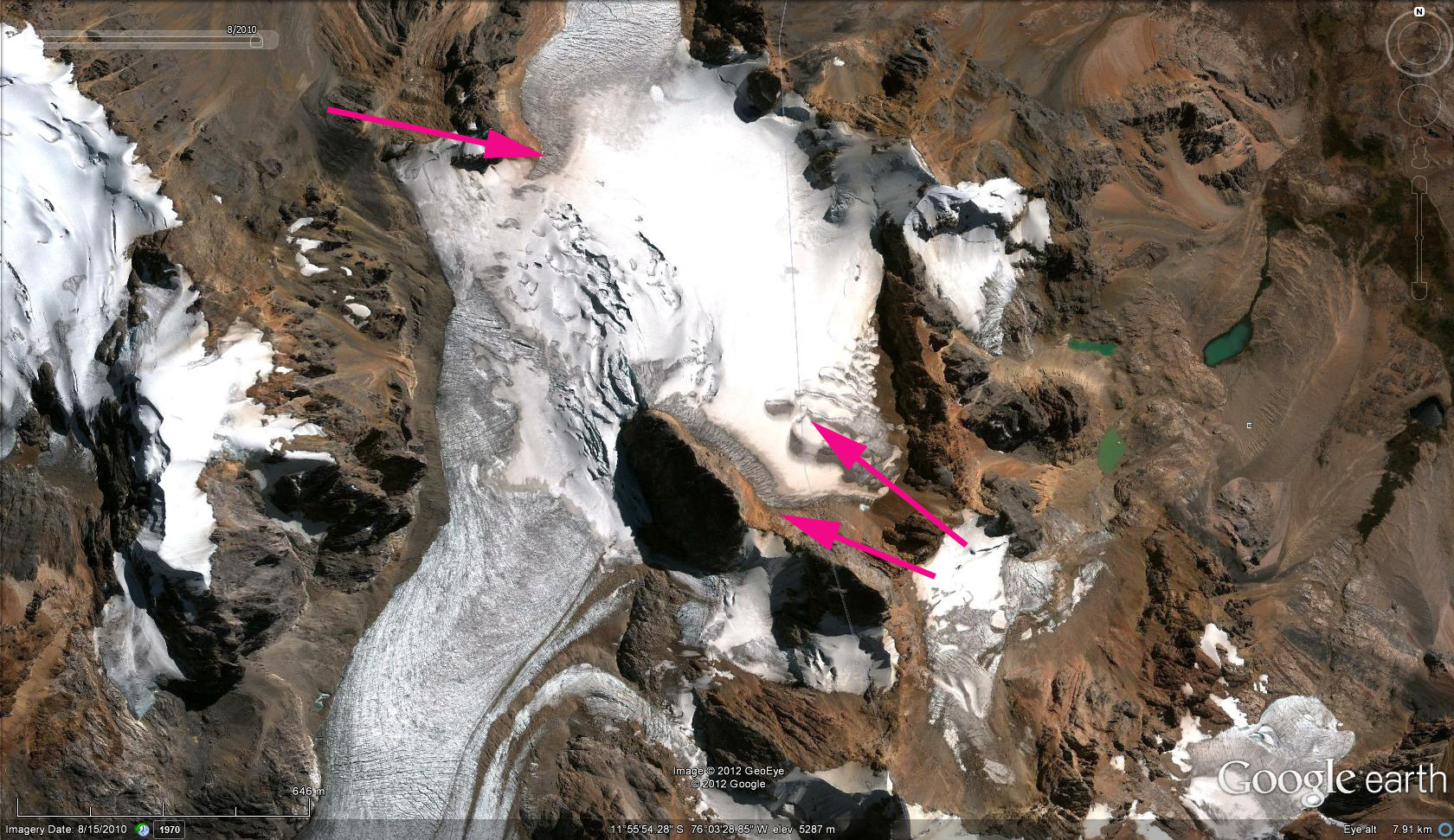November 4, 2012
Chuecon Glacier Retreat, Peru
Posted by Mauri Pelto
In the Cordillera Centrale of Peru a series of glaciers extends north from Pariacaca. Pariacaca is the pre-Incan god of water, appropriate name in this dry region, that is draped with glaciers and has numerous alpine lakes. In fact with glacier retreat the number of lakes is increasing. Here we examine the Chuecon Glacier which descends from Nevado Suerococha, and ends in a new lake before draining into the Rio Carhuapampa.  This area has has escaped attention on its recent retreat. The retreat of the Chuecon Glacier over the last decade is documented with a comparison of Landsat and Google Earth imagery from 1997, 1998, 2005,2010 and 2012. The Chuecon Glacier terminus is indicated with a pink arrow in the Landsat images. The green arrow is the Manon Glacier. In 1997 and 1998 the lake at the terminus has not yet begun to form, by 2005 a small lake has developed at the north corner of the terminus. By 2010 the lake is 450 meters from north to south and 150 to 200 m east to west. The retreat from 1997 to 2010 is 200 meters.
This area has has escaped attention on its recent retreat. The retreat of the Chuecon Glacier over the last decade is documented with a comparison of Landsat and Google Earth imagery from 1997, 1998, 2005,2010 and 2012. The Chuecon Glacier terminus is indicated with a pink arrow in the Landsat images. The green arrow is the Manon Glacier. In 1997 and 1998 the lake at the terminus has not yet begun to form, by 2005 a small lake has developed at the north corner of the terminus. By 2010 the lake is 450 meters from north to south and 150 to 200 m east to west. The retreat from 1997 to 2010 is 200 meters. 



 A closeup view of the glacier indicates that even in the accumulation zone bedrock is being exposed amidst the icefall and the accumulation zone margin in retreating, pink arrows in both images.
A closeup view of the glacier indicates that even in the accumulation zone bedrock is being exposed amidst the icefall and the accumulation zone margin in retreating, pink arrows in both images.
 The terminus currently is calving into the lake some, an upwelling area where the subglacial glacier runoff stream enters the lake is evident, yellow arrow. The terminus area also has ablation depressions forming an indication of stagnation, principally on the southern arm of the glacier, pink arrows. The purple arrow on the bottom image indicates the terminus in 1997. The combination of limited accumulation area and ablation depressions indicative of stagnation indicate a glacier that is not only retreating, but will not survive (Pelto, 2010). The ongoing field work at Quelcaya Ice Cap, led by Doug Hardy at UMASS, provides a detailed view of what is happening to glaciers in the region. Bryan Mark at Ohio State University has also been observing detailed changes around Mount Pucaranra, Peru.
The terminus currently is calving into the lake some, an upwelling area where the subglacial glacier runoff stream enters the lake is evident, yellow arrow. The terminus area also has ablation depressions forming an indication of stagnation, principally on the southern arm of the glacier, pink arrows. The purple arrow on the bottom image indicates the terminus in 1997. The combination of limited accumulation area and ablation depressions indicative of stagnation indicate a glacier that is not only retreating, but will not survive (Pelto, 2010). The ongoing field work at Quelcaya Ice Cap, led by Doug Hardy at UMASS, provides a detailed view of what is happening to glaciers in the region. Bryan Mark at Ohio State University has also been observing detailed changes around Mount Pucaranra, Peru.



 Dean of Academic Affairs at Nichols College and Professor of Environmental Science at Nichols College in Massachusetts since 1989. Glaciologist directing the North Cascade Glacier Climate Project since 1984. This project monitors the mass balance and behavior of more glaciers than any other in North America.
Dean of Academic Affairs at Nichols College and Professor of Environmental Science at Nichols College in Massachusetts since 1989. Glaciologist directing the North Cascade Glacier Climate Project since 1984. This project monitors the mass balance and behavior of more glaciers than any other in North America.
[…] government policies during the pandemic in Matucana, a small highland district close to Lima, where glacial meltwater, from Pariacaca, also contributes to streamflow and irrigation supplies. She […]
[…] policies during the pandemic in Matucana, a small highland district close to Lima, where glacial meltwater, from Pariacaca, also contributes to streamflow and irrigation supplies. She […]